A Bioeconomic Analysis of the Sandfish (Arctoscopus japonicus) Management Policies of the Eastern Sea Danish Fishery in Korea
Abstract
1. Introduction
2. Materials
2.1. Sandfish Fishing Status
2.2. Data Analysis
3. Results
3.1. Process-Error Model
3.2. State-Space Model
3.3. Comparison of Analysis Results Obtained Using the Model
3.4. Analysis of the Effect of Sandfish Stock Rebuilding
4. Discussion
Author Contributions
Funding
Institutional Review Board Statement
Informed Consent Statement
Data Availability Statement
Conflicts of Interest
Appendix A
Appendix A.1. Methods
Appendix A.1.1. Surplus Production Model
Appendix A.1.2. Process-Error Model (CYP Model)
Appendix A.1.3. State-Space Model
Appendix A.1.4. Model Test
Appendix A.1.5. Economic Analysis
References
- Ministry of Oceans and Fisheries. Report of Fish Stock Rebuilding Plan Regional Scientific Committee; Ministry of Oceans and Fisheries: Sejong, Korea, 2020.
- Lee, S.G.; Midani, A.R. National comprehensive approaches for rebuilding fisheries in South Korea. Mar. Policy 2014, 45, 156–162. [Google Scholar] [CrossRef]
- National Institute of Fisheries Science. Target Fish Species of Fisheries Resources Recovery Project. Available online: https://www.nifs.go.kr/page?id=rec_fish (accessed on 15 February 2020).
- Kim, D.Y.; Lee, J.S.; Kim, D.H. A study on establishing the performance evaluation system of the fish stock rebuilding plans. J. Fish. Bus. Adm. 2011, 42, 15–29. [Google Scholar]
- Lee, S.I.; Yang, J.H.; Yoon, S.C.; Chun, Y.Y.; Kim, J.B.; Cha, H.K.; Choi, Y.M. Biomass estimation of sailfin sandfish in Korea waters. Korean J. Fish Aquat. Sci. 2009, 42, 487–493. [Google Scholar]
- Choi, J.Y.; Kim, D.H. An exploratory study on determining optimal fishing effort and production levels of danish seine fishery under the sandfish stock rebuilding plan. J. Fish. Bus. Admin. 2012, 43, 1–9. [Google Scholar] [CrossRef][Green Version]
- National Institute of Fisheries Science. Resource Status and Restoration Recommendation of Fisheries Resources in 2017; National Institute of Fisheries Science: Busan, Korean, 2017.
- Choi, M.J.; Kim, D.H. Assessment and management of small yellow croaker (Larimichthys polyactis) stocks in South Korea. Sustainability 2020, 12, 8257. [Google Scholar] [CrossRef]
- Choi, M.J. Comparing surplus production models for selecting effective stock assessment model: Analyzing potential yield of East Sea, Republic of Korea. Ocean Polar Res. 2019, 41, 183–191. [Google Scholar]
- Choi, M.J. A bioeconomic Analysis of Small Yellow Croaker for Planning Effective Management Policy. Master’s Thesis, Pukyong National University, Busan, Korea, 21 February 2020. [Google Scholar]
- Larkin, S.; Alvarez, S.; Sylvia, G.; Harte, M. Practical considerations in using bioeconomic modelling for rebuilding fisheries. OECD Food Agric. Fish. 2011, 1–38. [Google Scholar] [CrossRef]
- Clark, C.W. Mathematical Bioeconomics: The Optimal Management of Renewable Resources; John Wiley & Sons, Inc.: New York, NY, USA, 1990. [Google Scholar]
- Clark, C.W. Fisheries bioeconomics: Why is it so widely misunderstood? Popul. Ecol. 2006, 48, 95–98. [Google Scholar] [CrossRef]
- Davis, J.C. Rebuilding fisheries: Challenges for fisheries managers. In The Economics of Rebuilding Fisheries Workshop Proceedings; OCED: Paris, France, 2010; pp. 1–270. [Google Scholar]
- Schnute, J. Improved estimates from the Schaefer production model: Theoretical considerations. J. Fish. Board Can. 1977, 34, 583–603. [Google Scholar] [CrossRef]
- Clarke, R.; Yoshimoto., S.; Pooley, S. A bioeconomic analysis of the Northwestern Hawaiian Islands lobster fishery. Mar. Resour. Econ. 1992, 7, 115–140. [Google Scholar] [CrossRef]
- Millar, R.B.; Meyer, R. Non-linear state space modelling of fisheries biomass dynamics by using Metropolis-Hastings within-Gibbs sampling. J. R. Stat. Soc. C Appl. 2000, 49, 327–342. [Google Scholar] [CrossRef]
- de Valpine, P.; Hilborn, R. State-space likelihoods for nonlinear fisheries time-series. Can. J. Fish. Res. Board Can. 2005, 62, 1937–1952. [Google Scholar] [CrossRef]
- Winker, H.; Carvalho, F.; Kapur, M. JABBA: Just another Bayesian biomass assessment. Fish. Res. 2018, 204, 275–288. [Google Scholar] [CrossRef]
- Korean Fisheries Information Service. Fishery Production Statistics. Available online: http://fips.go.kr (accessed on 18 January 2020).
- Korea Fisheries Resources Agency. Coastal Fisheries Survey Report; FIRA-ER-17-018: Busan, Korea, 2017; pp. 307–311. [Google Scholar]
- Korean Statistical Information Service. Korean Statistical Information Service. Available online: http://kostat.go.kr (accessed on 18 January 2020).
- Haddon, M. Modelling and Quantitative Methods in Fisheries; CRC Press: New York, NY, USA, 2010; pp. 285–333. [Google Scholar]
- Kim, D.H. Bayesian Statistics Using R and WinBUGS; Freedom Academy: Paju, Korea, 2013; pp. 87–248. [Google Scholar]
- Spiegelhalter, D.J.; Thomas, A.; Best, N.; Lunn, D. WinBUGS User Manual. 2003. pp. 1–60. Available online: https://www.mrc-bsu.cam.ac.uk/wp-content/uploads/manual14.pdf (accessed on 15 March 2020).
- McAllister, M.K.; Pikitch, E.K.; Punt, A.E.; Hilborn, R. A Bayesian approach to stock assessment and harvest decisions using the sampling/importance resampling algorithm. Can. J. Fish. Aquat. Sci. 1994, 51, 2673–2687. [Google Scholar] [CrossRef]
- Zhang, C.I.; Kim, S.; Yoon, S.B. Stock assessment and management implications of small yellow croaker in Korean waters. Korean J. Fish. Aquat. Sci. 1992, 25, 282–290. [Google Scholar]
- Choi, Y.M.; Zhang, C.I.; Lee, J.B.; Kim, J.Y.; Cha, H.K. Stock assessment and management implications of chub mackerel, Scomber japonicus in Korean waters. Korean J. Fish. Aquat. Sci. 2004, 6, 90–100. [Google Scholar]
- Sohn, M.H.; Yang, J.H.; Park, J.H.; Lee, H.W.; Choi, Y.M.; Lee, J.B. Stock assessment and optimal catch of blackfin flounder Glyptocephalus stelleri in the East Sea, Korea. Korean J. Fish. Aquat. Sci. 2013, 46, 598–606. [Google Scholar]
- Sim, S.H.; Nam, J.O. A stock assessment of yellow croaker using bioeconomic model: A case of single species and multiple fisheries. Ocean. Polar Res. 2015, 37, 161–177. [Google Scholar] [CrossRef]
- Kim, D.H. Evaluating the TAC policy in the sandfish stock rebuilding plan. J. Fish. Bus. Admin. 2015, 46, 29–39. [Google Scholar] [CrossRef]
- Polacheck, T.; Hilborn, R.; Punt, A.E. Fitting surplus production models: Comparing methods and measuring uncertainty. Can. J. Fish. Aquat. Sci. 1993, 50, 2597–2607. [Google Scholar] [CrossRef]
- Christou, M.; Maynou, F.; Tserpes, G.; Stergiou, K.I.; Maravelias, C.D. Crash landing obligation for Mediterranean mixed fisheries: Evaluation of management strategies using bioeconomic modelling in the Aegean Sea. Sci. Mar. 2019, 83, 143–154. [Google Scholar] [CrossRef]
- Sgardeli, V.; Tserpes, G.; Maravelias, C.D. Optimizing effort allocation in data poor mixed fisheries. ICES J. Mar. 2019, 76, 1505–1514. [Google Scholar] [CrossRef]
- Schaefer, M.B. Some aspects of the dynamics of populations important to the management of the commercial marine fisheries. IATTC Bull. 1954, 1, 23–56. [Google Scholar]
- Fox, W.W. An exponential surplus-yield model for optimizing exploited fish populations. Trans. Am. Fish. Soc. 1970, 99, 80–88. [Google Scholar] [CrossRef]
- Pella, J.J.; Tomlinson, P.K. A generalized stock production model. IATTC Bull. 1969, 13, 416–497. [Google Scholar]
- Walters, C.J.; Hilborn, R. Adaptive control of fishing systems. J. Fish. Res. Board Can. 1976, 33, 145–159. [Google Scholar] [CrossRef]
- Meyer, R.; Millar, R.B. BUGS in Bayesian stock assessments. Can. J. Fish. Aquat. Sci. 1999, 56, 1078–1087. [Google Scholar] [CrossRef]
- Punt, A.E.; Hilborn, R. Bayesian Stock Assessment Methods in Fisheries: User’s Manual; Food and Agriculture Organization: Rome, Italy, 2001; pp. 1–68. [Google Scholar]
- Kwon, Y.J.; Zhang, C.I.; Pyo, H.D.; Seo, Y.I. Comparison of models for estimating surplus productions and methods for estimating their parameters. J. Korean Soc. Fish. Ocean Technol. 2013, 49, 18–28. [Google Scholar] [CrossRef][Green Version]
- Kim, H.A.; Seo, Y.I.; Cha, H.K.; Kang, H.J.; Zhang, C.I. A study on the estimation of potential yield for Korean west coast fisheries using the holistic production method (HPM). J. Korean Soc. Fish. Ocean Technol 2018, 54, 38–53. [Google Scholar] [CrossRef]
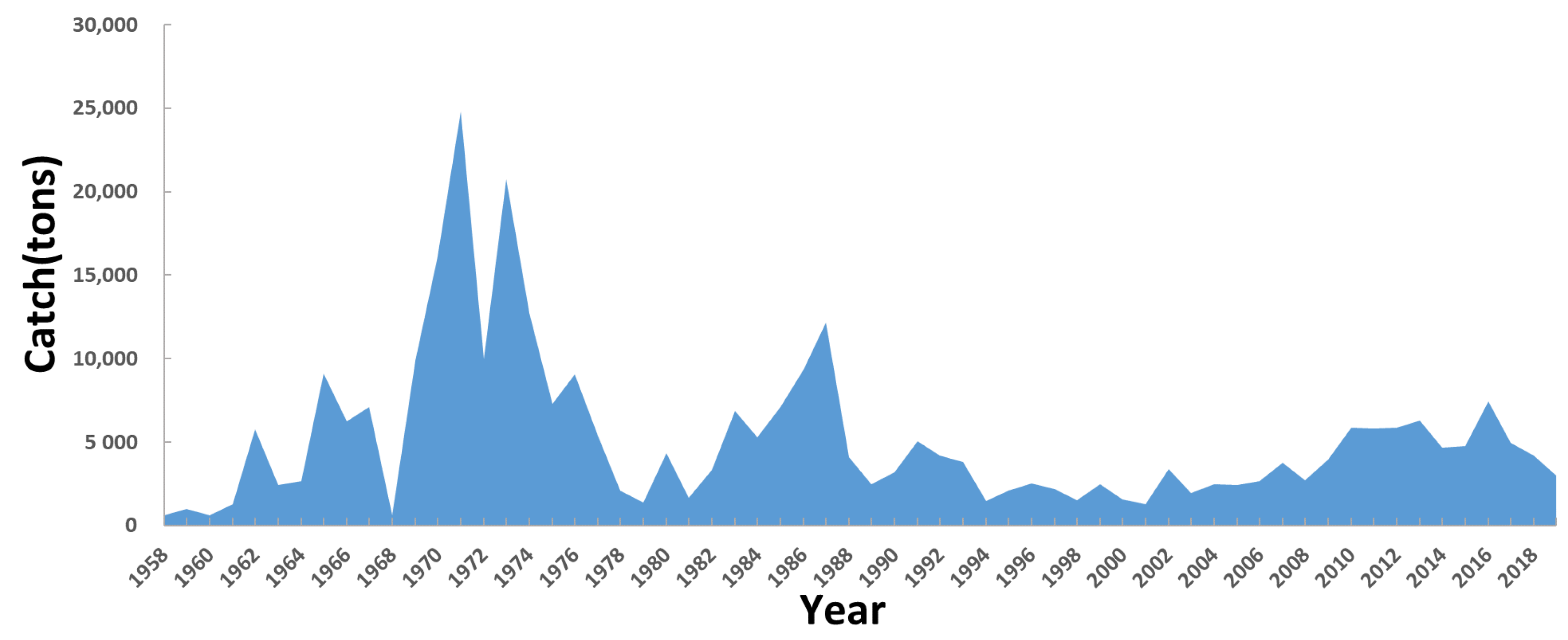
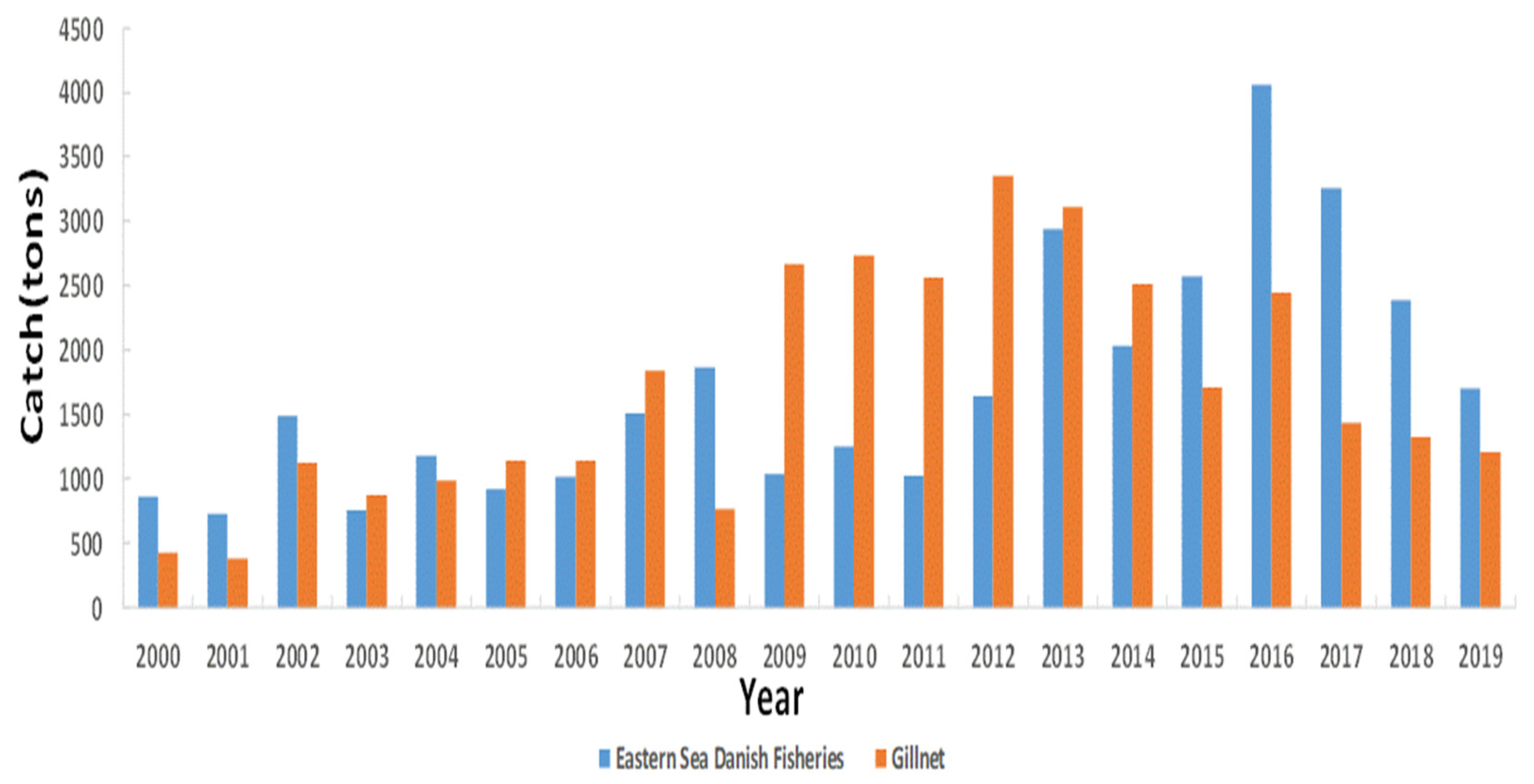

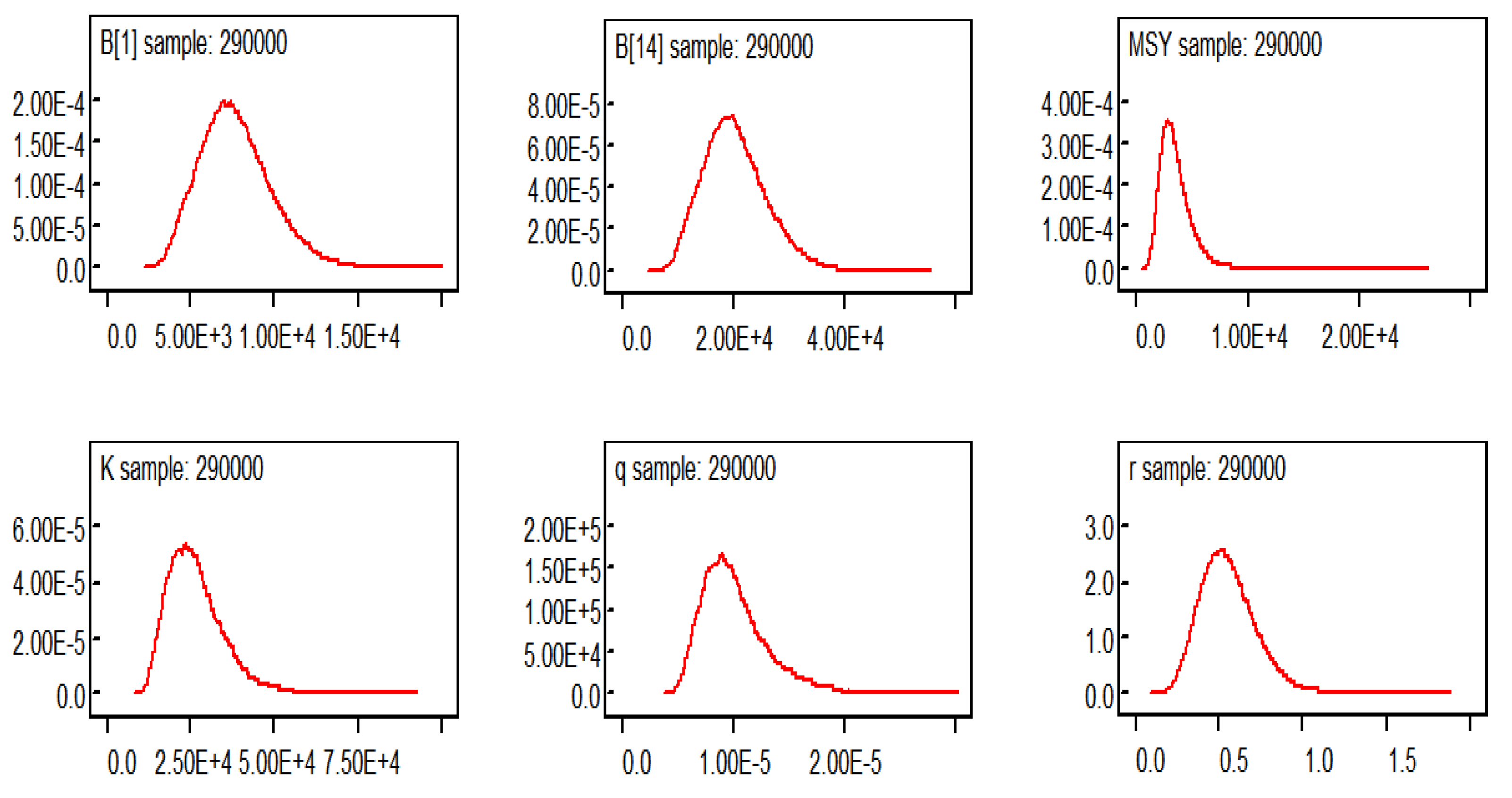
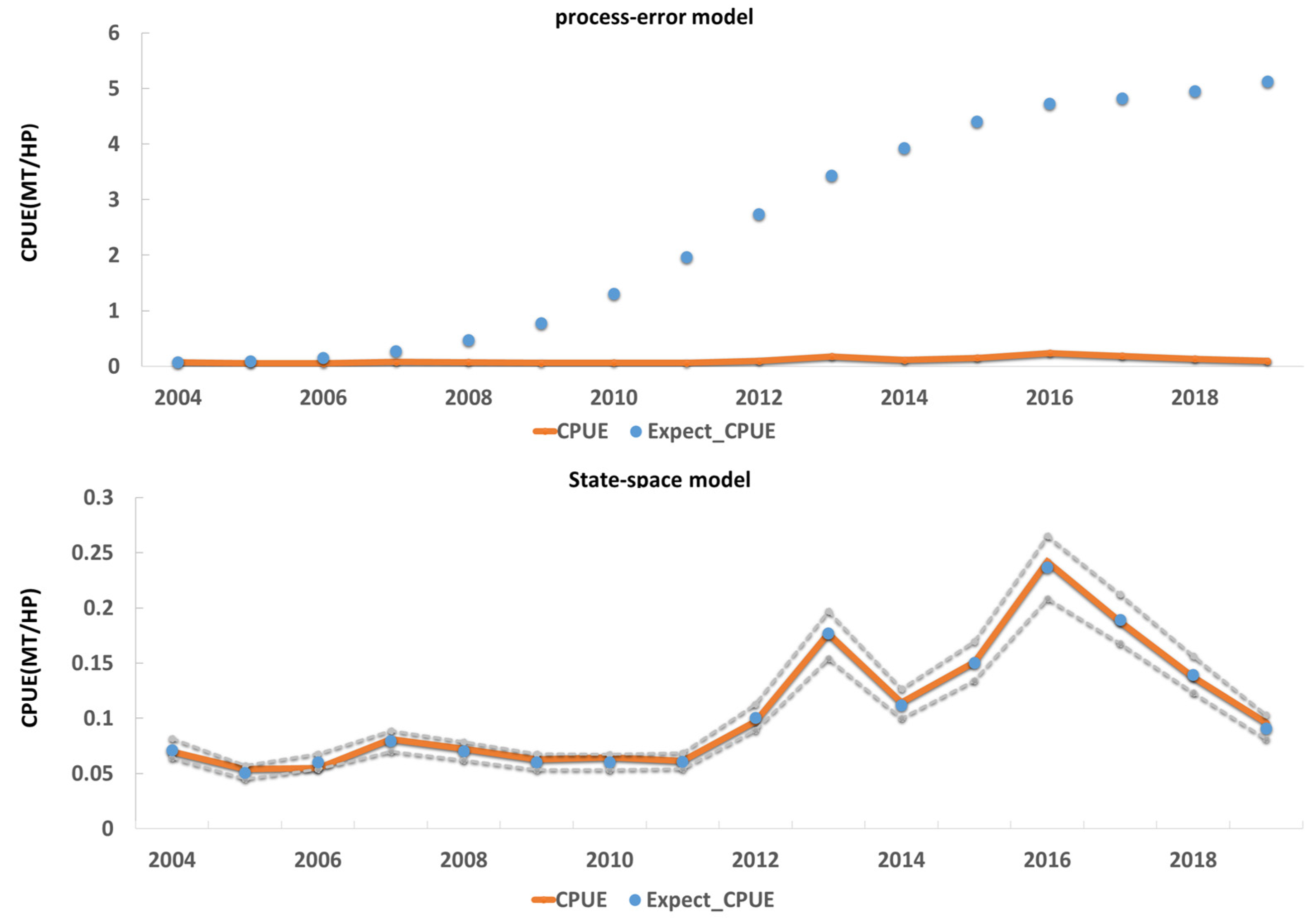
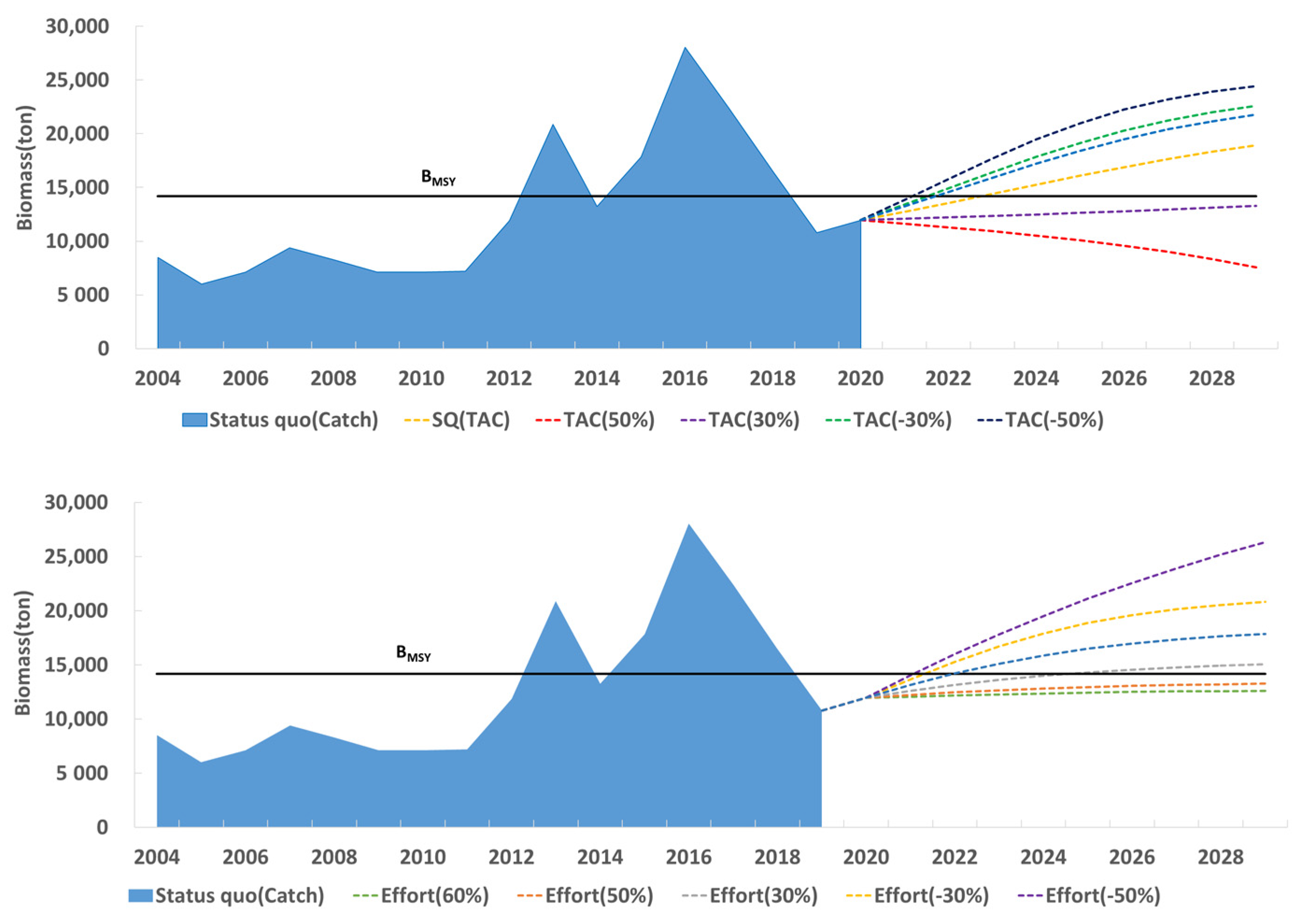
| Year | Catch (in MT) | Horsepower (HP) |
|---|---|---|
| 2004 | 1183 | 16,914 |
| 2005 | 923 | 17,142 |
| 2006 | 1021 | 18,544 |
| 2007 | 1514 | 18,656 |
| 2008 | 1871 | 25,776 |
| 2009 | 1042 | 16,557 |
| 2010 | 1253 | 19,441 |
| 2011 | 1027 | 16,659 |
| 2012 | 1648 | 16,963 |
| 2013 | 2936 | 16,588 |
| 2014 | 2035 | 17,822 |
| 2015 | 2569 | 17,011 |
| 2016 | 4058 | 16,784 |
| 2017 | 3255 | 17,360 |
| 2018 | 2389 | 17,389 |
| 2019 | 1705 | 17,796 |
| Parameter | Biomass (ton) (2004) | Biomass (ton) (2019) | Intrinsic Growth | Catchability Coefficient | Carrying Capacity (ton) | MSY (ton) |
|---|---|---|---|---|---|---|
| Standard error | 2401 | 3088 | 0.1427 | 0.00000252 | 9824 | 1319 |
| Monte Carlo error | 89 | 113 | 0.0016 | 0.00000010 | 395 | 32 |
| MC error/SE | 3.6% | 3.6% | 1.1% | 3.8% | 4.0% | 2.4% |
| Parameter | Process-Error Model | State-Space Model | ||
|---|---|---|---|---|
| 2.50% | Median | 97.5% | ||
| MSY (ton) | 9820 | 1391 | 3031 | 6500 |
| BMSY (ton) | 34,316 | 7800 | 14,190 | 25,600 |
| K | 68,631 | 15,600 | 28,380 | 53,200 |
| q | 0.00009 | 0.000005121 | 0.000008444 | 0.00001484 |
| r | 0.38 | 0.20 | 0.42 | 0.76 |
| R² | 0.57 | 0.99 | ||
| RMSE | 3.023 | 0.0029 | ||
| TAC | Stock Biomass (MT) | Catch (MT) | NPV (Thousand Won) | HP | Stock Biomass (MT) | Catch (MT) | NPV (Thousand Won) |
|---|---|---|---|---|---|---|---|
| Status Quo (2019, Catch) | 21,771 | 1705 | 241,776 | Status quo (2019, HP) | 17,868 | 2685 | 162,817 |
| 2196 MT (2019, TAC) | 18,806 | 2196 | 246,462 | 60% | 12,590 | 1611 | 57,964 |
| 50% | 7587 | 3294 | 60,980 | 50% | 13,273 | 2992 | 79,233 |
| 30% | 13,304 | 2855 | 226,294 | 30% | 15,052 | 2940 | 123,868 |
| −30% | 22,589 | 1537 | 222,108 | −30% | 20,815 | 2189 | 164,140 |
| −50% | 24,446 | 1098 | 172,599 | −50% | 26,321 | 1978 | 159,503 |
Publisher’s Note: MDPI stays neutral with regard to jurisdictional claims in published maps and institutional affiliations. |
© 2021 by the authors. Licensee MDPI, Basel, Switzerland. This article is an open access article distributed under the terms and conditions of the Creative Commons Attribution (CC BY) license (https://creativecommons.org/licenses/by/4.0/).
Share and Cite
Choi, J.-H.; Lee, J.-B.; Yoon, S.-C.; Kim, D.-H. A Bioeconomic Analysis of the Sandfish (Arctoscopus japonicus) Management Policies of the Eastern Sea Danish Fishery in Korea. Sustainability 2021, 13, 7868. https://doi.org/10.3390/su13147868
Choi J-H, Lee J-B, Yoon S-C, Kim D-H. A Bioeconomic Analysis of the Sandfish (Arctoscopus japonicus) Management Policies of the Eastern Sea Danish Fishery in Korea. Sustainability. 2021; 13(14):7868. https://doi.org/10.3390/su13147868
Chicago/Turabian StyleChoi, Ji-Hoon, Jae-Bong Lee, Sang-Chul Yoon, and Do-Hoon Kim. 2021. "A Bioeconomic Analysis of the Sandfish (Arctoscopus japonicus) Management Policies of the Eastern Sea Danish Fishery in Korea" Sustainability 13, no. 14: 7868. https://doi.org/10.3390/su13147868
APA StyleChoi, J.-H., Lee, J.-B., Yoon, S.-C., & Kim, D.-H. (2021). A Bioeconomic Analysis of the Sandfish (Arctoscopus japonicus) Management Policies of the Eastern Sea Danish Fishery in Korea. Sustainability, 13(14), 7868. https://doi.org/10.3390/su13147868







